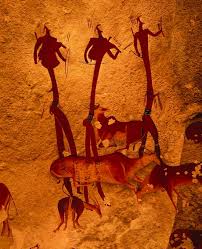The San Bushmen have no ‘Chiefs’. Every Bushman is considered “chief” over himself – or herself. This is strange for those accustomed to a society governed by hierarchy. In the unique Bushman societal structure there was a balance between communalism and individuality and no one had any form of formal authority over another.
As I said, a strange concept to grasp for those unaccustomed to such ways.
 The San would persuade others through a commitment to conversation in which eloquence, skill and wisdom would serve as guides in whatever was being discussed. Children were included in almost all activities and conversations. To quote Louis Herman, in his masterful book, Future Primal, “Coherence was maintained by collections of stories, myths and teachings – a shared but open-ended cosmology”.
The San would persuade others through a commitment to conversation in which eloquence, skill and wisdom would serve as guides in whatever was being discussed. Children were included in almost all activities and conversations. To quote Louis Herman, in his masterful book, Future Primal, “Coherence was maintained by collections of stories, myths and teachings – a shared but open-ended cosmology”.
I suspect that leaders could learn a thing or two from such ways!
Against this backdrop, Lorna Marshall wrote, “Chiefs are as thin as the rest”. How far we have moved away from this in most expressions of leadership practice in today’s world. Today, those given the responsibility to lead, see themselves as entitled to more than the rest. After all, isn’t that how it should be? Isn’t that the ‘spoils’ of leadership – just reward for the title? Isn’t that the natural order – leaders given and taking more than those below? It has become an unchallenged assumption and an abused ‘right’. It is justified in all kinds of ways and supported by systems that discriminate, manipulate and distort how we perhaps are meant to be and co-exist. It has happened for as long as we can remember and is “just the way things are”.
But why?
I recall a client where the CEO flew business class and the rest of his executive economy. Not only did he insist on business class but would complain if he was seated at the rear of business class! An extreme example perhaps, yet one that is symbolic of all that is wrong with leadership thinking and practice. Something has to give and until leaders understand they are there to serve, such actions will continue.
When it comes to leadership practice there is much we can learn from the San Bushmen and how they ordered their society and relationships. I suspect that we have moved so far from such order that even thinking about any form of implementation would seem extreme. That is a pity but I hope there are leaders bold enough to pause, to think again and see what might be done within their sphere of influence.
Why not?

